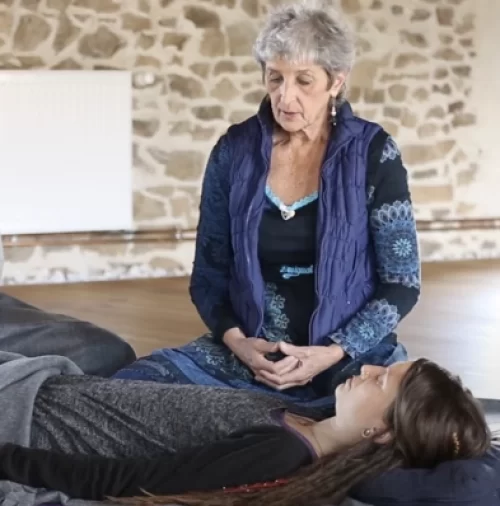CONSCIOUS BREATHING FOR TRAUMA RECOVERY (CBTR)
Free online conscious breathing education that is both simple and effective

The CBTR training has been created by Brigitte Martin Powell and Judee Gee, breath specialists and breathwork trainers based in the UK and in France. Judee and Brigitte are former Presidents of the IBF. At the time of developing this programme they were sitting on the IBF-UN working group committee which develops Conscious Breathing projects in alignment with the United Nations 2030 Agenda for Sustainable Development.
The CBTR programme was originally designed for refugees, migrants and victims of natural disasters as well as health care workers, staff and volunteers of relief organisations.
It has been now extended to include anyone suffering from trauma, anxiety, burnout and depression.
The goal of the CBTR programme is to provide free online conscious breathing education that is both simple and effective through:
- Giving practical instructions for developing an awareness of current breathing habits
- Teaching specific breathing exercises to recalibrate the autonomic nervous system
What is coherent breathing
Coherent Breathing and the Autonomic Nervous System
Um componente importante do sistema de resposta ao estresse é o sistema nervoso autônomo, que gerencia as funções automáticas do corpo, incluindo os sistemas cardiovascular, respiratório, digestivo, hormonal, glandular e imunológico. O sistema nervoso autônomo tem dois ramos principais: o sistema nervoso simpático – o sistema de luta ou fuga – e o sistema nervoso parassimpático – o resto e digerir ou alimentar e procriar– sistema.
Idealmente, ambos os sistemas são obrigados a intervir para ações específicas ao longo do nosso cotidiano, mas a longo prazo é necessário um equilíbrio entre os dois. Um corpo que está constantemente estresse mental, físico ou emocional (sistema simpático) sem tempo para descansar, integrar e repor (sistema parassimpático), não será capaz de funcionar de forma ideal e sofrerá as consequências.

There is one automatic function of the body that can be voluntarily controlled through our breath and that is the respiratory system! Técnicas conscientes de respiração proporcionam fácil acesso à rede de comunicação autônoma e, mudando nossos padrões respiratórios, enviamos mensagens específicas ao cérebro que têm efeitos poderosos em nossos pensamentos, emoções e comportamentos. Por exemplo, quando nos sentimos ansiosos, apenas alguns minutos de Respiração Coerente podem acalmar nossa mente preocupada e promover uma tomada de decisão mais racional – em vez de impulsiva – tomada de decisão.
Prática coerente de respiração: Respirar ao ritmo de 5 respirações por minuto é o ritmo ideal de respiração para reequilibrar o corpo e acessar um estado interno de relaxamento que é pacífico e tranquilo. Cinco respirações por minuto correspondem a respirar por 6 segundos e sair por 6 segundos, ligando o in-breath e o fôlego de forma relaxada.
Como praticar: Comece progressivamente, respirando conscientemente e de forma relaxada por 3 segundos e 3 segundos para fora, até que se sinta confortável. Em seguida, passe para respirar por 4 segundos e 4 segundos para fora e progredir em seu próprio ritmo até 6 segundos dentro e 6 segundos para fora. Pessoas mais altas podem querer respirar mais lentamente.
Onde praticar: Comece encontrando um lugar tranquilo onde você pode ficar imperturbável por vários minutos. Condições de luz suave ou escuridão vão ajudá-lo a relaxar. Tenha um cobertor leve na mão para ter certeza de que você se mantenha aquecido. Sente-se ou deite-se em uma posição confortável e comece sua prática. Uma vez que você se sinta confortável com a prática, você pode aplicá-lo em uma ampla gama de situações (sentar, andar…).
Quando praticar: Três vezes por dia durante cinco minutos (365) é um ótimo começo, e se você pode aplicar a prática diariamente por algumas semanas, você vai colher mais benefícios. Mesmo um minuto de respiração coerente ajudará a reequilibrar seu sistema nervoso. Stephen Elliot sugere 20 min por dia por um período de 21 dias, a fim de recalibrar o sistema nervoso e instalar o reflexo da respiração coerente como uma prática padrão.
The CBTR training has been created by Brigitte Martin Powell and Judee Gee, breath specialists and breathwork trainers based in the UK and in France. Judee and Brigitte are former Presidents of the IBF. At the time of developing this programme they were sitting on the IBF-UN working group committee which develops Conscious Breathing projects in alignment with the United Nations 2030 Agenda for Sustainable Development.
CBTR VIDEOS
Watch the trailer:
Watch the Presentation:
Watch the Demonstration:
Credits
Thanks to the IBF Development Fund for funding the development of the CBTR training programme in Athens, Greece.
THE CBTR MANUALS
THE IBF BREATHING APP
This free app is the perfect tool to practice the CBTR Program – and much more.
It is now available for free for iPhones on the Apple Store and for Androids on the Google Play Store. The name of the app is IBF Breathing App.
If you want to get more detailed information about the IBF Breathing app, click here:

For more information about Coherent Breathing
Keywords for Internet search
Respiração Consciente
Holotrópica
Coherent Breathing
Stephen Elliott
Sympathetic and Parasympathetic Nervous System
Heart Rate Variability (HRV)
Disclaimer
This presentation is designed to provide helpful guidance for recovering from trauma and reinforcing natural resiliency, but should not be used to diagnose or treat any health or medical conditions requiring medical supervision.
The publisher and authors are not liable for any consequences from the application by any person using the information provided in the presentation. Even though conscious breathing is simple and safe, some may find this method challenging, and are encouraged to consult a conscious breathing specialist in order to progress in the practice.